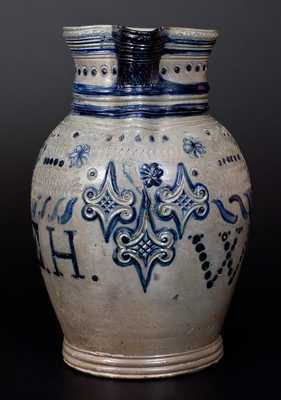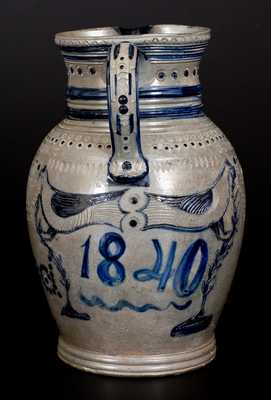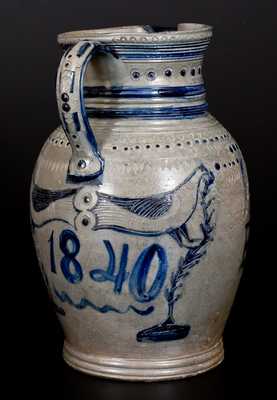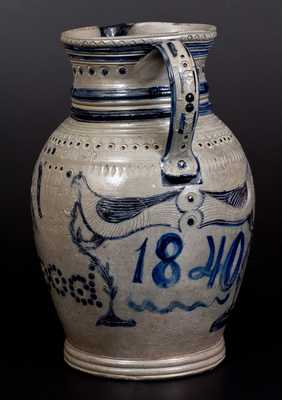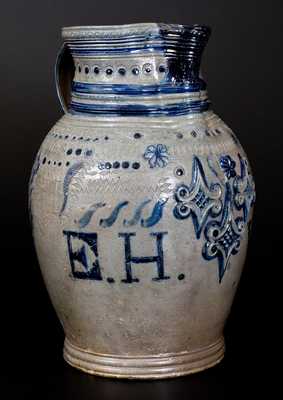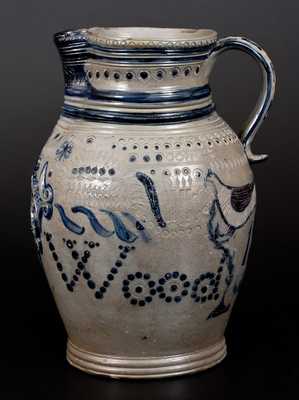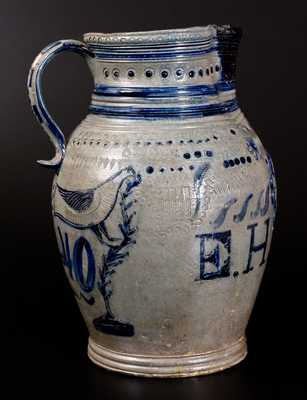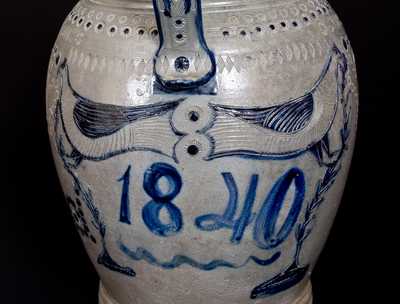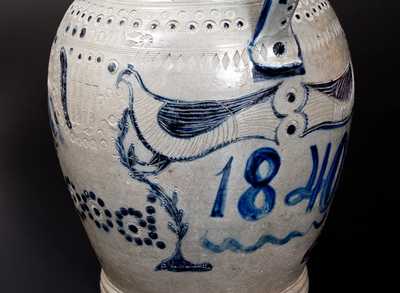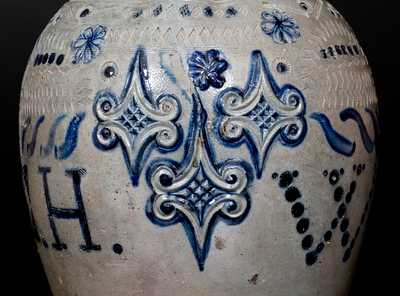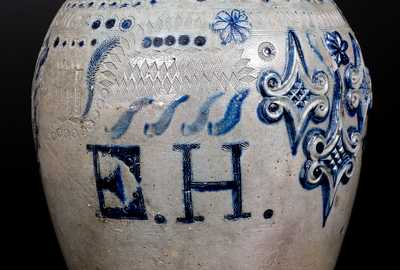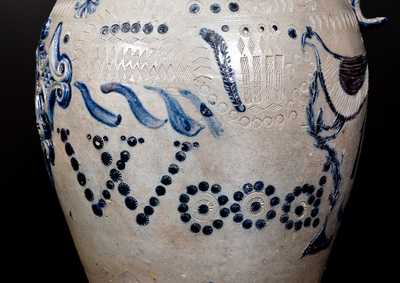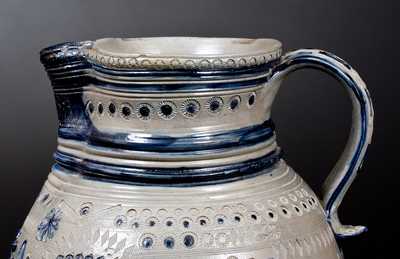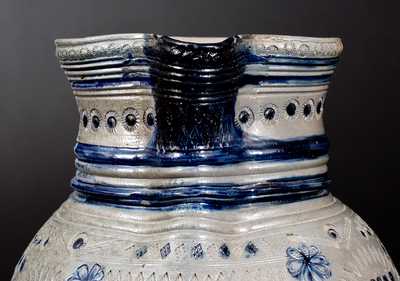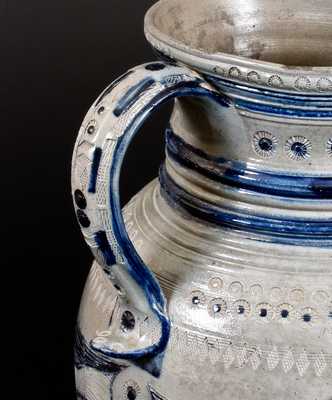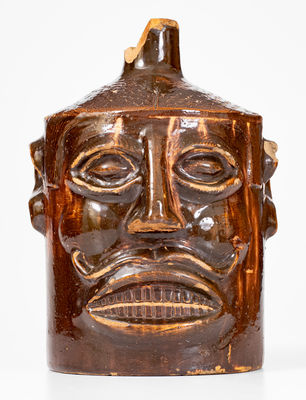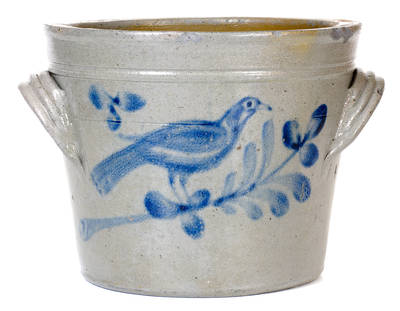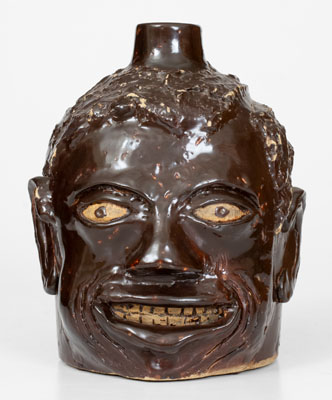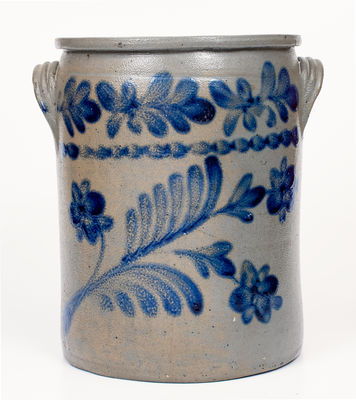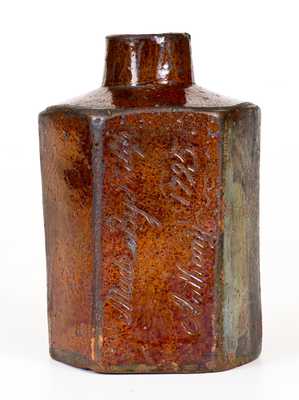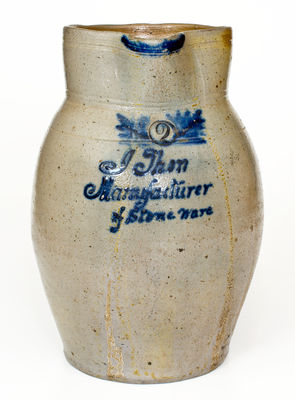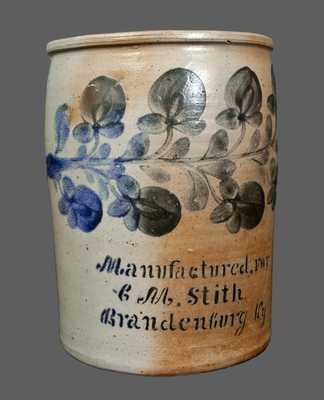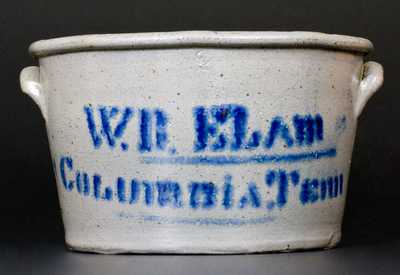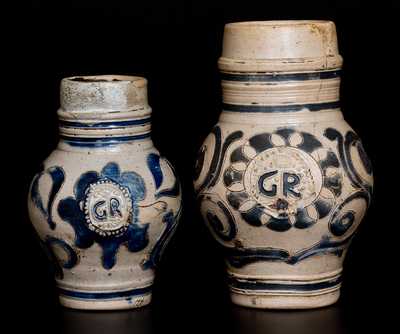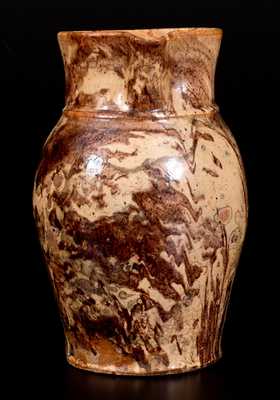Important and Unique Three-Gallon Stoneware Pitcher with Profuse Incised Bird-on-Branch Motifs and Applied and Impressed Decoration, Stamped "E.H. Wood" and Dated "1840", Ezekiel H. Wood, Maysville, Kentucky, 1840, large-sized pitcher with stepped base, heavily-tooled collar, and ribbed strap handle with upturned terminal, the surface profusely-decorated throughout with the following treatments: incised bird-in-tree motifs, accented with impressed rosettes and flanking the brushed cobalt date "1840"; the large name, "E.H. Wood", composed of various decorative impressions, flanking molded and applied geometric and floral devices; incised leaves to the midsection; and heavy impressed decoration to the body, collar, and handle, created from at least twelve different tools, each individually stamped in a painstaking, almost obsessive fashion. Heavy cobalt highlights are brushed throughout the impressed, incised, and applied designs in a precise manner. Additional cobalt brushwork appears in the form of S-shaped strokes at the midsection, a V-shaped highlight on the interior of the spout, and a squared accent at the base of the handle.
Four different techniques- incising, impressing, sprigging, and slip-decorating- give life to this masterwork, creating an object of overwhelming visual appeal. These lavish decorative treatments abound on what is perhaps the most-elegantly-potted stoneware pitcher we have seen, potted with a delicate, thin-walled construction and in an imposing three-gallon capacity.
The Museum of Early Southern Decorative Arts artisan database notes that Ezekiel Wood and his brother, John, manufactured stoneware together in Maysville, Kentucky during the 1845 time period. A relatively small number of undecorated or modestly-decorated stoneware pieces bear the maker's mark, "J & E. WOOD." One of the finest surviving works from this firm is a jar bearing the stenciled cobalt inscription, "MAYSVILLE, KY / 1845", which currently resides in the MESDA collection.
Born December 12, 1818 in Brown County, Ohio, Ezekiel Wood moved to Mason County, Kentucky when still a young boy. Ezekiel and his brother, John, are shown living together in Maysville in the 1850 federal census, which also lists their occupations as farmers. Living adjacent to their home was a potter named Alfred Moss, indicating they were operating a pottery manufactory at that time. History of Howard and Cooper Counties, Missouri, writing about E.H. Wood in 1883, states, "Mr. W. is an industrious, successful farmer, and is well-to-do in life. Farming, however, is not the only industry he has followed. He was engaged in 'flat-boating' to and from New Orleans for some time in an early day, and later he was a manufacturer of stoneware for about six years." Indeed, many early American potters were primarily farmers who produced stoneware or earthenware to supplement their incomes.
While it is possible that this pitcher was made for Ezekiel Wood at a pottery he owned or was associated with, it seems to be the case that Wood himself threw and decorated this work. Its craftsmanship is at such a high level and its decoration so extremely elaborate that it appears to have been Wood's masterpiece--the object he made coming out of his stoneware potter's apprenticeship to prove his skill. This fits perfectly with Wood's age at the time; having been born at the end of 1818, he would have been twenty-one for almost the entirety of the year 1840-- twenty-one being the standard age of release from an indentured apprenticeship. This object, potted in large proportions with oversized signature, would have been easily visible to passersby in the window of Wood's shop, at a local fair, or any other place of business. The amount of time taken to create this work, its unwieldy use as an actual pitcher, and the immaculate condition in which it survives, all corroborate the notion that it was made as a display piece to advertise Wood's pottery.
Of interesting note is the fact that Wood was part of an extended family of Maysville stoneware potters, namely Rulef Ricketts, Hugh Cooper, Isaac Thomas, Evan Ricketts, and Joseph Claghorn Mendell. In 1853, he married Mary Ellen Power, a relative, most likely the sister, of prominent Maysville merchant and stoneware seller, Hugh Power. Wood would eventually move to Missouri in the mid 1860's and remained there until his death in 1900.
This tour-de-force of ceramic art is regarded as the second most profusely-decorated American stoneware pitcher known, the first being the iconic Harrington & Burger pitcher with hound handle, which currently resides in the New York State Museum's Weitsman Stoneware Collection. Among the numerous American stoneware pitchers still in existence today, this pitcher ranks among the finest examples of the form known. Provenance: A fresh-to-the-market example, purchased by the consignor approximately twenty-five years ago. This pitcher, despite its delicate potting, survives in excellent, essentially as-made condition. H 15 1/2".

